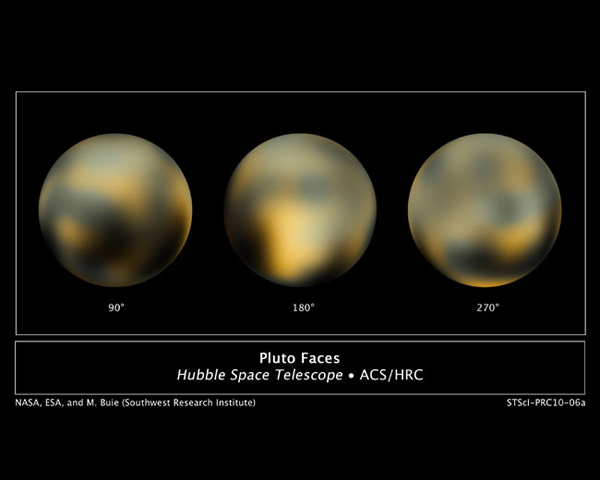The Greatest Mysteries of Pluto

Each week Life's Little Mysteries presents The Greatest Mysteries of the Cosmos, starting with our solar system.
For more than 70 years since its discovery in 1930, Pluto had the distinction of being the ninth and final planet in the solar system. But the detection of other objects such as Eris, which is more massive than Pluto, in the distant dark sectors of Pluto's neighborhood led to the world's demotion in 2006 to "dwarf planet" status.
Since then, astronomers and a ticked-off public have debated whether or not Pluto should qualify as a planet . This brouhaha just goes to show how little is truly known about Pluto and its cousins at the far reaches of the Solar System. The best images we have of the icy rock come from the Hubble Space Telescope, and even they look more like Rorschach blots than revelatory pictures.
To better understand Pluto and other objects in the so-called Kuiper Belt a ring of frozen bodies beyond Neptune NASA launched the New Horizons mission, ironically, in 2006. When the probe arrives in 2015, the data it collects will help solve Pluto's greatest mysteries, which are:
What is Pluto truly like?
Interplanetary spacecraft have gathered crucial data regarding the three other terrestrial planets in addition to Earth Mercury , Venus and Mars and all four gas giants: Jupiter , Saturn , Uranus and Neptune.
Pluto, however, represents an entirely new category of object in an unknown "Third Region" of the solar system.
Get the world’s most fascinating discoveries delivered straight to your inbox.
"We've never been to this kind of place," said Alan Stern, principal investigator for New Horizons and a planetary scientist and associate vice president in the Space Science Division at the Southwest Research Institute in Texas.
Scientists have a rudimentary idea of Pluto's rocky and icy composition, though materials, and the proportions they exist in, are somewhat guesswork. A thin atmosphere consists of nitrogen, methane and carbon monoxide. From Hubble images, Pluto's surface looks like one of contrasts, with both bright and dark regions.
Once viewed from (relatively) up close, Pluto's surface could turn out to have cold-liquid-belching cryovolcanoes or geysers. Scoping out the surface's geology and chemistry might also reveal signs that Pluto is home to a giant underground ocean.
"Everything we know about Pluto today can go on a couple 3 by 5 [inch] cards," Stern told Life's Little Mysteries. With New Horizons, "we're going to go from filling up 3 by 5 cards to filling up an encyclopedia."
Where Pluto arose
Pluto goes around the Sun in an oval-shaped orbit that does not reside in the plane of other planetary orbits, which ring the Sun's equator. Periodically, Pluto actually cuts in front of Neptune, becoming closer to the sun than the eighth planet. [Will Pluto Ever Hit Neptune? ]
How Pluto got to have such an orbit speaks to the world's history and where it came together. Astronomers think Pluto and other Kuiper Belt objects formed from the same disk of material around the Sun that begat the other major bodies in the solar system.
Then, early in the solar system's history, gravitational interactions between the gas giants moved Uranus and Neptune significantly further out from the sun. In the process, scientists believe, Pluto and the Kuiper Belt gang were largely scattered. Many of those objects that stayed in the solar system did so in disrupted, odd orbits.
"I don't know where [Pluto] formed, but I do know there was a migration," said Stern. Someday, with more data, Stern said, the full story might be able to be told.
What objects circle Pluto?
To date, four moons have been discovered around Pluto, the fourth discovered this July when the Hubble Space Telescope was searching the area for a possible ring system.
Pluto's moons Charon, Nix, Hydra and the new unnamed one orbit unusually close to their host world. Charon is proportionally one of the biggest satellites in the solar system it's diameter of about 750 miles (1,207 kilometers) is greater than half Pluto's diameter of about 1,440 miles (2,320 kilometers). Charon's so big and so close that some consider it and Pluto a "double dwarf planet." [Hell of a Choice: Cerberus Leads for New Pluto Moon Name ]
A good number of more satellites, as well as those sought-after rings, might surround Pluto. New Horizons will be on the lookout.
"We will take a full census of all the satellites," said Stern. "With the discovery of that fourth [moon], we feel that the floodgates are open."
Bonus boggler: So, is Pluto a planet after all?
The definition of a planet adopted by a small group of astronomers at a 2006 meeting of the International Astronomical Union left Pluto out in the cold . Pluto joined Ceres the biggest asteroid and newfound Kuiper Belt bodies including Eris, Haumea and Makemake in a newly created dwarf planet category.
As other objects are catalogued in Pluto's realm, and a greater variety of planetary types are discovered around other stars, Stern thinks the definition of planethood will soon welcome Pluto back into the fold. [Read: Fighting for Pluto's Planet Title: Q & A With Planetary Scientist Alan Stern]
"Pluto is the Chihuahua of planets," Stern said. "But that doesn't mean it's not a dog."
- 5 Strange Facts About Pluto
- When Will Pluto Complete its First Orbit Since Discovery?
- How Much Would You Weigh on Pluto?
Follow Life's Little Mysteries on Twitter @llmysteries, then join us on Facebook.



